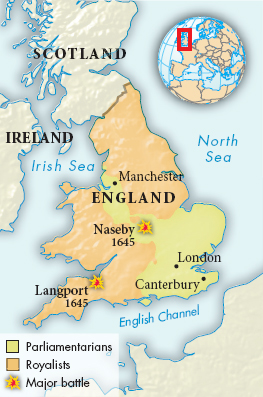Religious Divides and the English Civil War
Relations between the king and the House of Commons were also embittered by religious issues. In the early seventeenth century, growing numbers of English people felt dissatisfied with the Church of England established by Henry VIII (r. 1509–
James I responded to such ideas by declaring, “No bishop, no king.” For James, bishops were among the chief supporters of the throne. His son and successor, Charles I, further antagonized religious sentiments. Not only did he marry a Catholic princess, but he also supported the heavy-

Charles had ruled from 1629 to 1640 without Parliament, financing his government through extraordinary stopgap levies considered illegal by most English people. Most members of Parliament were not willing to trust such a despotic king with an army. Many supported the Scots’ resistance to Charles’s religious innovations. Accordingly, this Parliament, called the “Long Parliament” because it sat from 1640 to 1660, enacted legislation that limited the power of the monarch and made government without Parliament impossible.
In 1641, the Commons passed the Triennial Act, which compelled the king to summon Parliament every three years. The Commons impeached Archbishop Laud and then threatened to abolish bishops. King Charles, fearful of a Scottish invasion, reluctantly accepted these measures.
The next act in the conflict was precipitated by the outbreak of rebellion in Ireland, where English governors and landlords had long exploited the people. In 1641, the Catholic gentry of Ireland led an uprising in response to a feared invasion by anti-
Without an army, Charles I could neither come to terms with the Scots nor respond to the Irish rebellion. After a failed attempt to arrest parliamentary leaders, Charles left London for the north of England. There, he recruited an army drawn from the nobility and its cavalry staff, the rural gentry, and mercenaries. In response, Parliament formed its own army, the New Model Army, composed of the militia of the city of London and country squires with business connections.
The English civil war (1642–